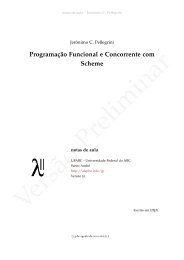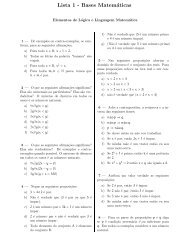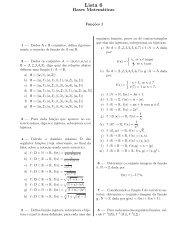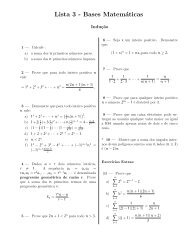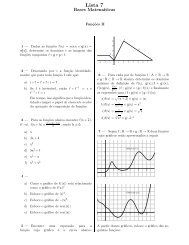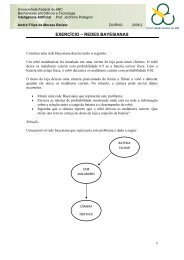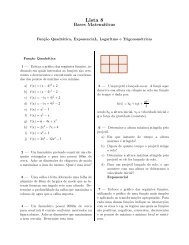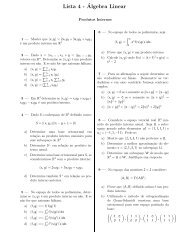Programação Linear (e rudimentos de otimização não-linear)
Programação Linear (e rudimentos de otimização não-linear)
Programação Linear (e rudimentos de otimização não-linear)
You also want an ePaper? Increase the reach of your titles
YUMPU automatically turns print PDFs into web optimized ePapers that Google loves.
notas <strong>de</strong> aula – versão 64 - Jerônimo C. Pellegrini<br />
2.2. SOLUÇÕES VIÁVEIS PARA PROGRAMAS LINEARES 29<br />
Demonstração. Seja K o conjunto <strong>de</strong> soluções ótimas, x ∗ 1 , x∗ 2 ∈ K, e z∗ o<br />
valor ótimo da função objetivo. Então,<br />
c T x ∗ 1 = cT x ∗ 2 = z∗ .<br />
Como são viáveis, x ∗ 1 , x∗ 2<br />
∈ S e S é convexo, portanto<br />
Temos então<br />
λx ∗ 1 + (1 − λ)x∗ 2 ∈ S, 0 ≤ λ ≤ 1.<br />
c T (x ∗ 1 , x∗ 2 ) = λcT x ∗ 1 + (1 − λ)cT x ∗ 2<br />
= λz ∗ + (1 − λ)z ∗ = z ∗ .<br />
Assim, λx ∗ 1 + (1 − λ)x∗ 2<br />
∈ K, para 0 ≤ λ ≤ 1, e K é convexo.<br />
<br />
Corolário 2.41. Se há mais <strong>de</strong> uma solução ótima para um programa <strong>linear</strong>,<br />
há uma quantida<strong>de</strong> infinita e não enumerável <strong>de</strong>las.<br />
Claramente, o conjunto <strong>de</strong> soluções ótimas contém um único ponto<br />
se for um ponto extremo isolado, ou infinitos pontos, se for a envoltória<br />
convexa <strong>de</strong> alguns pontos extremos.<br />
Teorema 2.42. Se existe solução viável para um programa <strong>linear</strong>, então<br />
também existe solução viável básica.<br />
Demonstração. Sejam a 1 , a 2 , . . . , a n as colunas <strong>de</strong> A, e x = (x 1 , x 2 , . . . , x n )<br />
viável:<br />
x 1 a 1 + x 2 a 2 + . . . = b.<br />
Suponha, sem perda <strong>de</strong> generalida<strong>de</strong>, que as k primeiras variáveis <strong>de</strong> x,<br />
são maiores que zero, e portanto x 1 a 1 + x 2 a 2 + . . . + x k a k = b.<br />
Trataremos dois casos: no primeiro, a 1 , . . . , a k são <strong>linear</strong>mente in<strong>de</strong>pen<strong>de</strong>nte.<br />
No segundo, são <strong>linear</strong>mente <strong>de</strong>pen<strong>de</strong>ntes.<br />
Primeiro caso (colunas L.I.): nesta situação, k ≤ m, porque A tem posto<br />
completo.<br />
Versão Preliminar<br />
• Se k = m a solução é, por <strong>de</strong>finição, básica.<br />
• Se k < m, então m − k colunas po<strong>de</strong>m ser obtidas <strong>de</strong> A para formar<br />
uma matriz m × m com colunas a 1 , . . . , a k , . . . , a m , todas L.I.



